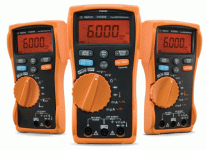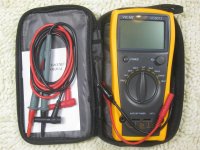If the meter does not have the fuses accessible under a trap door (only few do), blowing one can be a drag. So avoiding in series is a good consideration especially when the amperage can have might in a fault. Like with battery sources. Do you have a graphical guide to the car people of the procedure of using very low ohm shunt current measuring in detail? They would love it for checking their big wattage D amp draw, deciding AWG in rewiring etc. I suppose.
I don't have anything (as of now) on measuring the current draw. I do have guides for selecting wire size on the site.
Very nice practical website you got there BTW. Tips down to even how to macro photo the boards! Awesome.
Some link for those who wanna see about ''shunt'' resistor current measurement since we mentioned. Ammeter design : DC METERING CIRCUITS
Some link for those who wanna see about ''shunt'' resistor current measurement since we mentioned. Ammeter design : DC METERING CIRCUITS
Since you mentioned the photo section, you may have only seen the basic repair page. The second link in the sig line is to the main site.
I have their MS8218 50000 counts self calibrating top one (supposedly, maybe a wild claim) which proved good for accuracy over some years, can do DC+AC average, true RMS, has good diode testing range. Fast & latching continuity testing, rather slow auto ranging for the money, very nice uA and mA range accurate with enough digits for matching JFETs.
Yeah I have that one too as I'm addicted to more digits 😀 Mine ran into a problem because the circuitry to detect whether probes were plugged into the right sockets kept telling me I had them in the wrong sockets. I found some corrosion around the sockets when I opened it up, have not been able to fix this. Other than this (which means I haven't used it for a while) it has been a great meter. I got it to replace a UNI-T (also 4.5 digit) which became very unreliable on ohms but has a great power measurement function which still gets used from time to time.
These days I'm using this Fluke because its continuity is the fastest responding I've come across and its a dinky, compact handheld size:

Since you mentioned the photo section, you may have only seen the basic repair page. The second link in the sig line is to the main site.
I have seen all the links. Impressive body of work in a most comprehensive manner. You should get a book with a DVD disc published also. Will become the car audio enthusiast's hands on bible.
Yeah I have that one too as I'm addicted to more digits 😀 Mine ran into a problem because the circuitry to detect whether probes were plugged into the right sockets kept telling me I had them in the wrong sockets. I found some corrosion around the sockets when I opened it up, have not been able to fix this. Other than this (which means I haven't used it for a while) it has been a great meter. I got it to replace a UNI-T (also 4.5 digit) which became very unreliable on ohms but has a great power measurement function which still gets used from time to time.
These days I'm using this Fluke because its continuity is the fastest responding I've come across and its a dinky, compact handheld size:
That is why mine won't see the toolbox ever and will stay indoors. Great spec for the $ but not inspiring / adequate for toolbox duty.
I am inclined towards a sturdy more compact one for that. Like your 115C but loaded with auto hold, uA range, logging to computers, accessible fuses, AAA cells, 500h lasting, back flashlight even. And check its latest comms thingy out Agilent U1177A - YouTube, waiting they stock up to get em together.
Attachments
I am thinking of buying one of these,are they any good?
VC6013 digital capacitor / capacitance meter 200pf to 20mF discharge | eBay
VC6013 digital capacitor / capacitance meter 200pf to 20mF discharge | eBay
Attachments
i was looking at those.... i seen this while browsing dont know how well it works. but should be good for identifying those blank transistors we all come by.
http://www.ebay.com/itm/Peak-atlas-...365?pt=LH_DefaultDomain_0&hash=item3f14a1eac5
http://www.ebay.com/itm/Peak-atlas-...365?pt=LH_DefaultDomain_0&hash=item3f14a1eac5
Post #48:
The capacitor tester on the VC97 is absolutely useless and unreliable.
Post #49:
Generally, if the transistor needs anything more than what you can do with a multimeter, it's defective and no device can tell you what it is.
The capacitor tester on the VC97 is absolutely useless and unreliable.
Post #49:
Generally, if the transistor needs anything more than what you can do with a multimeter, it's defective and no device can tell you what it is.
these are excellent meters you can find them for about 75 bucks........
True RMS Digital Multimeter with Temperature, Capacitance &
includes capacitance AND frequenty counting
True RMS Digital Multimeter with Temperature, Capacitance &
includes capacitance AND frequenty counting
The forum lost the long post for the UT61 that I typed. It's not worth re-typing. It's better than the vichy. I'd give it a B+ grade. It's usable and all functions work but for repair work, I'd only recommend it to the casual user.
Nice, happy that my suggestion did not make you throw good money away. How did the post go? Server hick up? What you did not find inspiring mainly with it? Durability?
I don't know what happened to the post. I generally copy the text before I post it in case that happens (it used to happen quite alot) but I forgot this time.
I wouldn't have considered it throwing good money away. Education costs. Most people don't realize that. I do. Even when I buy something that's useless, I've learned something. I often buy two identical pieces and destroy one just to see how it's put together. Of course, this isn't generally done for anything costing more than about $20.
I'll use the meter for a few days but it will end up like many of the other cheap meters I have, sitting on a shelf with a pile of other meters.
The meter is very slow compared to better meters. no beep on diode check, no indication that it's actually doing anything when it's waiting to update the display....
It's an OK meter and someone who has never used a good meter would think it's perfectly fine. It would be a great buy at $30. At $45, it's OK. For the casual user, it's likely going to be acceptable but it will be too expensive for many and those who can easily afford it should buy something better if they're going to use it for repair work.
I wouldn't have considered it throwing good money away. Education costs. Most people don't realize that. I do. Even when I buy something that's useless, I've learned something. I often buy two identical pieces and destroy one just to see how it's put together. Of course, this isn't generally done for anything costing more than about $20.
I'll use the meter for a few days but it will end up like many of the other cheap meters I have, sitting on a shelf with a pile of other meters.
The meter is very slow compared to better meters. no beep on diode check, no indication that it's actually doing anything when it's waiting to update the display....
It's an OK meter and someone who has never used a good meter would think it's perfectly fine. It would be a great buy at $30. At $45, it's OK. For the casual user, it's likely going to be acceptable but it will be too expensive for many and those who can easily afford it should buy something better if they're going to use it for repair work.
Fair review. The $60 one the UT61E is much faster auto-ranging but the price moves.
What about its capacitor range? Fair VS the Vichy?
What about its capacitor range? Fair VS the Vichy?
The capacitor range is better because the vichy barely works and is useless on most values. For a 330uf cap, it takes 8 seconds to read. One problem is that it gives no indication that it's doing anything. For a 0.047uf cap, it reads 0.058uf. The cap read correctly on two other meters (Fluke 12 and Sencore LC102). The readings were the same with the leads or with the capacitor directly touching the contacts in the banana jacks.
Unless someone wants me to check something specific, I'm no longer going to post anything on the vichy.
Another problem with the UT61A is that it cannot lock onto waveforms that are not simple. A class D amp oscillating at 87kHz read anything from about 50k to 255k. It did OK on the legs of the transistors that were swinging rail to rail but on the gates or on the point where the two output filter inductors connected, it could not produce reliable readings. An old (1996/97) model 87 and a model 112 locked onto all points immediately.
The reason I compare them to the Fluke meters is to show that the points are not impossible to read reliably.
Another problem with the UT61A is that it cannot lock onto waveforms that are not simple. A class D amp oscillating at 87kHz read anything from about 50k to 255k. It did OK on the legs of the transistors that were swinging rail to rail but on the gates or on the point where the two output filter inductors connected, it could not produce reliable readings. An old (1996/97) model 87 and a model 112 locked onto all points immediately.
The reason I compare them to the Fluke meters is to show that the points are not impossible to read reliably.
So it's time for me to get a Fluke. Where's a good place to shop US mail-order?
Fluke Digital Multimeters - Test Equipment Depot
- Status
- Not open for further replies.
- Home
- General Interest
- Car Audio
- Cheap Multimeter

